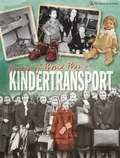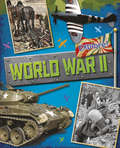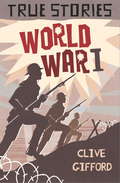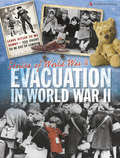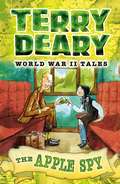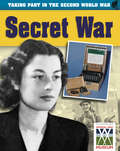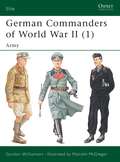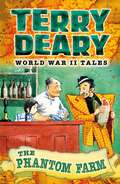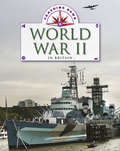Special Collections
World War 2
Description: books and accessible images to support themed learning about World War 2.
- Table View
- List View
World War II German doodlebug (UEB contracted)
by RnibThis page shows two images of the flying bomb, the V1 nicknamed doodlebug. At the top of the page seen from the side and in the bottom and middle of the page a plan view seen from above. There is a locator dot shown, which will be at the top left of the page when the image is the correct way up. Both views have the front on the left and the tail on the right of the page. In the top side view the body of the flying bomb is fatter on the left than the right. It is very streamlined. Halfway along the body the end of the wing can be found. It is angled up slightly to give the bomb lift when it flies. The pulse jet engine on the right is mounted onto the top of the bomb by two brackets. The end of the engine on the left is for air intake and the end on the right is the exhaust thrust. In the plan view image in the bottom and middle of the page the body of the bomb goes from left to right in the centre of the image. The wings go up and down the page from the body. On each wing there is a German cross indicating the bomb belongs to the Luftwaffe. The upper surface is green although sometimes camouflage colours were used so it was difficult to spot from the air. The underneath colour is a pale sky colour so it would be difficult to spot from the ground when flying.
Second World War Recruitment Poster - "Together" (tactile)
by RnibThis poster was used throughout the Empire and Commonwealth to recruit people to fight with Britain in the Second World War. Men and women came to the UK to work in industry, nursing and the armed forces as volunteers. Over 3 million people supported the UK in the armed forces of the Commonwealth. Almost 2.5 million Indians volunteered to help Britain fight. This is the largest volunteer army in history. Just under half of today's black and Asian population in the UK originate from cultural and ethnic groups that served and worked here during the Second World War. Description of the poster This coloured recruitment poster looks like a painting and shows seven fully uniformed members from the Commonwealth marching together under a flying Union Jack flag. The head-to-waist images of the men are shown in three diagonal rows - three at the front, two in the middle and two at the back. All are facing towards the right of the poster and are carrying rifles over their left shoulders with the rifle butt supported by their left hands. The front row, from left to right, has a Canadian airman (blue uniform), an Australian soldier (khaki uniform), and a British Navy sailor (navy uniform). The middle row, from left to right, has a South African soldier (cream uniform) and a New Zealand soldier (khaki uniform). The back row, from left to right, has a West African soldier (cream uniform) and an Indian soldier (khaki uniform). All men are white and clean-shaven, except the West African soldier, who is black, and the Indian soldier, who dark skinned with a beard. It is each man's uniform hat that distinguishes him and his country. Colour is used in the poster to represent the red, white and blue of the Union Jack and the colours on the men's uniforms. The poster has a white border with a large black band across the bottom that contains the word "together" in yellow capitals. The only other readable words on the poster are "Canada" on the sleeve badge of the Canadian airman and "H.M.S. Victory" on the headband of the British Navy sailor.
Kindertransport
by A.J. StonesCan you imagine leaving your home and your family, and moving hundreds of miles away, to a different country, because it was too dangerous to stay in your own country? During World War II, this was the situation millions of people, many of them children, faced. Stories of World War II: Kindertransport tells the story of the Jewish children who left Germany, Austria, Czechoslovakia and Poland without their parents in 1939, before the outbreak of World War II, and came to Britain on the Kindertransport. The book explains what happened, why they had to leave their homes, how they came to Britain and what happened to them when they arrived. Much of the material on which the book is based comes from The National Archives, and so is made up of government documents and reports from during World War II. This gives the book a real grounding in fact and in history - it is a true account of what life was like for the children of the Kindertransport during World War II.The other book in the series, Stories of World War II: Evacuation, tells the story of children evacuated from British towns and cities to the countryside during World War II.
Avro Lancaster Bomber (UEB uncontracted)
by RnibThis page shows two images of an aircraft. At the top of the page seen from the side and in the bottom and middle of the page a plan view seen from above. There is a locator dot shown, which will be at the top left of the page when the image is the correct way up. Both views have the front on the left and the tail on the right of the page. The aircraft is shown in a flying position so the front wheels are retracted and not shown. The aircraft in the top of the page has a transparent nose cone on the left which is where the bomb aimer sits. Up and right from this is the fore gunner's turret. Up and right from this again is the main cockpit cover. Down from the cockpit are two propellers. They are attached to engines which hang off the wing. To the right of the propellers is a small rectangle which comprises six exhaust outlets on the outer side of the outside engine. Right from the exhaust is the tip of the wing pointing towards you. The centre of the fuselage has letters identifying which individual aircraft it is. There is also a red and blue roundel indicating the plane belongs to the RAF. On the top edge of the fuselage there is a gun turret with the gun pointing up and to the right. Right of this the fuselage continues to one of the vertical tail fins. On the right of this is a vertical flap. This is one of the ailerons used to manoeuvre the aircraft when it is flying. The tail has a red rectangle and a blue rectangle separated by a white line indicating the plane belongs to the RAF. Down from the tail fin is the single rear wheel. To the right of the tail is the rear gun turret with the gun pointing right and down. In the plan view image in the bottom and middle of the page the fuselage goes from left to right in the centre of the image. The main wings go up and down the page from the fuselage. On the left the fuselage starts with a transparent nose cone which is where the bomb aimer sits. Right from this is the fore gunner's turret. Its guns cross above the bomb aimer. Right from this is the main cockpit cover. There are two small hatches in the centre of the fuselage and right from them is a gun turret with the guns pointing to the right. The fuselage finishes on the right with the rear gun turret with the guns pointing to the right. In the centre of the page the main wings each have two engines and propellers sticking out to the left. To the right of the propellers six exhaust outlets can be found on the top and bottom edge of each engine. Towards the end of each wing is a red and blue roundel indicating the plane belongs to the RAF. On the right of each wing tip is a flap. These are two of the ailerons used to manoeuvre the aircraft when it is flying. On the right of the page is the tailplane. The right half of each tail wing is a flap. These are two more of the ailerons used to manoeuvre the aircraft when it is flying. The ends of the tail wing, up and down the page have the ends of the two vertical fins showing. The plane is green although it was also commonly painted with camouflage colours. The underside is dark grey or black. This would mean the aircraft was difficult to detect from the ground when out on night bombing raids.
World War Two
by Jane BinghamThis photographic book gives you an overview of World War Two. From how the war began to how it spread worldwide, the new technology that was used in war for the first time, how women's roles changed in society because of the war, what life was like on the home front, and how the war was recorded in pictures, diaries, poems and stories. You can learn about key figures, such as Winston Churchill, and events, such as The Holocaust. You can also read a diary entry from the Blitz and learn how to create your own secret code.
World War II field gun (UEB contracted)
by RnibThis is an image of a side view of a large gun facing to the left and some of the shells it could fire. There is a locator dot shown, which will be at the top left of the page when the image is the correct way up. The muzzle is in the top left of the page and the gun barrel slopes down to the right. Halfway down it goes through a protective shield shown edge on. The breech is shown as a rectangle at the end of the barrel, where a shell would be loaded. Down from the breech is a circular handle which is used to change the angle of the barrel so the correct range is found. Down and to the left of the handle is one of the large wheels needed to move the gun from one battle to another. It has very knobbly tyres. It is attached to the gun carriage which is up and right from the wheel. The end of the carriage on the right is where the gun is hooked onto the vehicle to tow it. There are five shells standing vertically to the left of the gun and one, lying on its side, pointing to the right under the carriage to the right.
World War One
by Clive GiffordThe book contains nine short stories dealing with different aspects of life during World War I.World War I includes the stories of flying aces such as the 'Red Baron', the story of Lawrence of Arabia and the stories of brave doctors and nurses such as Edith Cavell in German occupied Belgium.Complete with glossary, further reading section and index.
World War II gas mask (UEB uncontracted)
by RnibThis page shows an image of a man wearing a gas mask. There is a locator dot shown, which will be at the top left of the page when the image is the correct way up. Only his head and shoulders are shown facing forwards, surrounded by an image border. Some of his brown hair is shown at the top of the image. There are two gas mask straps going over the top of his head. His face is hidden by the body of the mask. His eyes can be found staring out through the eyepieces. An ear pokes out to the left and right. The gas mask filter hangs down from where his nose and mouth would be. The round end with small holes in and the some of the side is shown. It is like a wide round can. He wears a brown open necked shirt with one button showing.
Evacuation
by A.J. StonesCan you imagine leaving your home and your family, and moving hundreds of miles away to live with strangers, because it was too dangerous to stay in your hometown? During World War II, this was situation millions of people, the majority of them children, faced. Stories of World War II: Evacuation tells the stories of these children: where they came from, where they went, who looked after them, what they ate, and how they went to school, along with many other details about their lives as evacuees.Much of the material on which the book is based comes from The National Archives, and so is made up of government documents and reports from during World War II. This gives the book a real grounding in fact and in history - it is a true account of what life was like for evacuees during World War II.The other book in the series, Stories of World War II: Kindertransport, tells the story of Jewish children evacuated to Britain from Germany, Holland and Austria before the outbreak of World War II.
World War II German foot soldier (UEB uncontracted)
by RnibThis page shows an image of a soldier. There is a locator dot shown, which will be at the top left of the page when the image is the correct way up. The man is shown standing, from the front but with the head turned to the left so both arms and legs but only one eye and ear can be found. He wears a grey coloured uniform. He has a metal helmet on his head. His jacket has the flaps with buttons to two breast and two waist pockets showing. There is a decorative motive on each collar flap. Up from the breast pocket on the left there is the German military badge which is made from a bird and a swastika. There is a leather strap going from the shoulder on the left to the waist on the right. He has a leather belt with four leather pouches on it. His arms are straight and held out to the left and right. He wears trousers to just below the knee. He has long black leather boots on his feet.
World War II bombed street (large print)
by RnibThis page shows an image of bomb damaged houses surrounded by an image border. There is a locator dot shown, which will be at the top left of the page when the image is the correct way up. There are three terraced houses and an old fashioned lamp post. The house in the middle is nearly completely destroyed. Only part of a window with broken glass remains to the left of the open doorway. The lamp post is in front of this house and leans precariously to the left. The house on the left is only damaged upstairs. Some of the roof slates have been blown off exposing some of the roof timber. Some of the wall to the room above the front door is missing. The house on the right is damaged upstairs and downstairs. Lots of the roof slates have been blown off also exposing some of the roof timber. The left upstairs window is half missing with broken glass. Most of this room is missing. The downstairs room is half missing. Its window is intact although the glass is cracked. To the right the front door and the window above are not damaged.
World War II Tales
by Terry Deary and James De RueStories of the Second World War on the Home Front from the bestselling Terry Deary, author of the hugely successful Horrible Histories. In this retelling of an extraordinary true story, a pair of children realise that the odd strangers they see in their tiny Scottish village are German spies. Can the children alert the authorities or will the ruthless spies find them first?
World War II German doodlebug (large print)
by RnibThis page shows two images of the flying bomb, the V1 nicknamed doodlebug. At the top of the page seen from the side and in the bottom and middle of the page a plan view seen from above. There is a locator dot shown, which will be at the top left of the page when the image is the correct way up. Both views have the front on the left and the tail on the right of the page. In the top side view the body of the flying bomb is fatter on the left than the right. It is very streamlined. Halfway along the body the end of the wing can be found. It is angled up slightly to give the bomb lift when it flies. The pulse jet engine on the right is mounted onto the top of the bomb by two brackets. The end of the engine on the left is for air intake and the end on the right is the exhaust thrust. In the plan view image in the bottom and middle of the page the body of the bomb goes from left to right in the centre of the image. The wings go up and down the page from the body. On each wing there is a German cross indicating the bomb belongs to the Luftwaffe. The upper surface is green although sometimes camouflage colours were used so it was difficult to spot from the air. The underneath colour is a pale sky colour so it would be difficult to spot from the ground when flying.
World War II bren gun (large print)
by RnibThis is an image of a side view of a machine gun facing to the left. There is a locator dot shown, which will be at the top left of the page when the image is the correct way up. The muzzle is in the left of the page with the foresight sticking up from the barrel. The gun barrel goes right to the centre of the page. Just left of centre is a handle, it sticks up and right, the actual handle is nearly horizontal. To the right of this is a wide curved shape, also sticking up. This is the magazine full of bullets. The last thing sticking up on the right before the wooden butt is the back sight. Down and left from the butt on the right of the page is another wooden handle. To the left of it is an oval trigger guard and the trigger. On the left is a rod which goes down to the bottom left of the page. This is a rest stand to stabilise the gun when it is being fired. It can fold up to the right when the gun is being carried.
World War II gas mask (UEB uncontracted)
by RnibThis page shows an image of a man wearing a gas mask. There is a locator dot shown, which will be at the top left of the page when the image is the correct way up. Only his head and shoulders are shown facing forwards, surrounded by an image border. Some of his brown hair is shown at the top of the image. There are two gas mask straps going over the top of his head. His face is hidden by the body of the mask. His eyes can be found staring out through the eyepieces. An ear pokes out to the left and right. The gas mask filter hangs down from where his nose and mouth would be. The round end with small holes in and the some of the side is shown. It is like a wide round can. He wears a brown open necked shirt with one button showing.
Secret War
by Ann KramerThis book looks at the many ways in which secret operations helped defeat the enemy during the Second World War. Taking Part in the Second World War offers a history of the war told through the words of the people who took part. Author Ann Kramer skilfully weaves the threads together to build up a portrait of not only the events of the war, but also of those who served future generations so well.
World War II British foot soldier (large print)
by RnibThis page shows an image of a soldier. There is a locator dot shown, which will be at the top left of the page when the image is the correct way up. The man is shown standing facing forwards so both arms, legs, eyes and ears can be found. He wears a brown uniform. He has a metal dish-shaped helmet on his head. His tunic jacket has two breast pockets with the flaps and buttons showing. To the left and right of his neck is the top of his haversack showing, which is on his back. There is a canvas strap going from each shoulder to his waist and canvas belt. There are two large canvas pouches attached to the belt. His arm is straight and held down on the right. The arm on the left it is slightly bent and holds a rifle which is also resting on the ground. He wears trousers to just above the ankle. There is a large pocket on his hip to the left and a large pocket on his thigh to the right which also has a flap and button. His ankles are covered by cuffs. He has heavy black leather boots on his feet.
German Commanders of World War II
by Gordon Williamson and Malcolm McGregorThis first of two studies examines the careers and illustrates the appearance and uniforms of 19 of the German Army's leading field commanders in World War II. Their service covers the whole arc of that army's wartime experience, from stunning success in 1939–41, through the hugely costly middle years on the Russian Front to the stubborn defensive fighting in both East and West in 1943–45. Also included are five more junior unit commanders chosen because their service typifies the achievements of combat leaders in regimental and battalion commands. The colour portraits are in the uniquely meticulous style of the respected World War II illustrator Malcolm McGregor.
World War II Tales
by Terry Deary and James De RueStories of the Second World War on the Home Front from the bestselling Terry Deary, author of the hugely successful Horrible Histories. With food scarce and rationing taking hold, plenty of people turned to the black market to get more than their share. In this tale, a girl finds herself mixed up in a spiv's illegal dealings - and what is the secret of the haunted farm?
World War II bren gun (UEB uncontracted)
by RnibThis is an image of a side view of a machine gun facing to the left. There is a locator dot shown, which will be at the top left of the page when the image is the correct way up. The muzzle is in the left of the page with the foresight sticking up from the barrel. The gun barrel goes right to the centre of the page. Just left of centre is a handle, it sticks up and right, the actual handle is nearly horizontal. To the right of this is a wide curved shape, also sticking up. This is the magazine full of bullets. The last thing sticking up on the right before the wooden butt is the back sight. Down and left from the butt on the right of the page is another wooden handle. To the left of it is an oval trigger guard and the trigger. On the left is a rod which goes down to the bottom left of the page. This is a rest stand to stabilise the gun when it is being fired. It can fold up to the right when the gun is being carried.
World War II evacuee children (UEB contracted)
by RnibThis page shows an image of three small children. There is a locator dot shown, which will be at the top left of the page when the image is the correct way up. The children are shown standing facing forwards so both their arms, legs, eyes and ears can be found. There is a girl on the left, a boy in the middle and a smaller girl on the right. They each wear a luggage label which says their name and where they are being evacuated to. The girl on the left wears a short orange coat and a pink bonnet. She has a white box containing her gas mask hanging on a string around her neck. She has short pale grey socks and red sandals. The boy in the middle wears a brown cap and a very short grey coat. He has long grey socks which are wrinkled as they are falling down. He wears brown shoes and his gas mask box is on the ground to the left of them and rhere is a suitcase ti the right of them. The girl on the right wears a light purple coat to below her knees. On her head she has a small brown hat. She also has a white box containing her gas mask hanging on a string around her neck. She wears short pale grey socks and brown shoes.
World War II Tales
by Terry Deary and James De RueStories of the Second World War on the Home Front from the bestselling Terry Deary, author of the hugely successful Horrible Histories. With food scarce and rationing taking hold, plenty of people turned to the black market to get more than their share. In this tale, a girl finds herself mixed up in a spiv's illegal dealings - and what is the secret of the haunted farm?
World War II in Britain
by Liz Gogerly'The past is all around us, if we know where to look.' This series takes a look at archaeological, structural and museum evidence from around Britain, allowing readers to build up a picture of what life was like in key historical periods and how you can discover it for yourself by visiting sites around the country.
World War II field gun (UEB uncontracted)
by RnibThis is an image of a side view of a large gun facing to the left and some of the shells it could fire. There is a locator dot shown, which will be at the top left of the page when the image is the correct way up. The muzzle is in the top left of the page and the gun barrel slopes down to the right. Halfway down it goes through a protective shield shown edge on. The breech is shown as a rectangle at the end of the barrel, where a shell would be loaded. Down from the breech is a circular handle which is used to change the angle of the barrel so the correct range is found. Down and to the left of the handle is one of the large wheels needed to move the gun from one battle to another. It has very knobbly tyres. It is attached to the gun carriage which is up and right from the wheel. The end of the carriage on the right is where the gun is hooked onto the vehicle to tow it. There are five shells standing vertically to the left of the gun and one, lying on its side, pointing to the right under the carriage to the right.
World War II gas mask (large print)
by RnibThis page shows an image of a man wearing a gas mask. There is a locator dot shown, which will be at the top left of the page when the image is the correct way up. Only his head and shoulders are shown facing forwards, surrounded by an image border. Some of his brown hair is shown at the top of the image. There are two gas mask straps going over the top of his head. His face is hidden by the body of the mask. His eyes can be found staring out through the eyepieces. An ear pokes out to the left and right. The gas mask filter hangs down from where his nose and mouth would be. The round end with small holes in and the some of the side is shown. It is like a wide round can. He wears a brown open necked shirt with one button showing.

